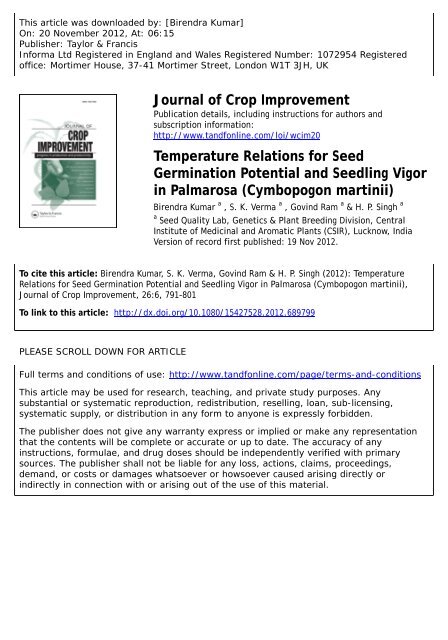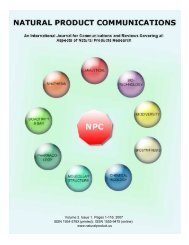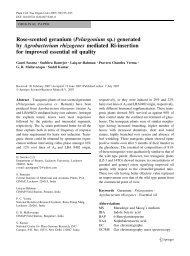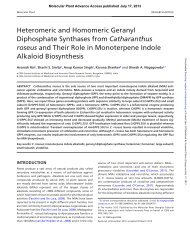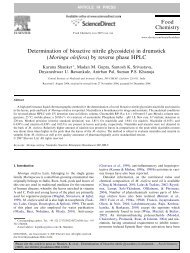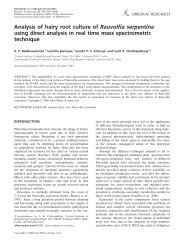Birendra Kumar*, SK Verma, G Ram,HP Singh. 2012 ... - CIMAP Staff
Birendra Kumar*, SK Verma, G Ram,HP Singh. 2012 ... - CIMAP Staff
Birendra Kumar*, SK Verma, G Ram,HP Singh. 2012 ... - CIMAP Staff
- No tags were found...
Create successful ePaper yourself
Turn your PDF publications into a flip-book with our unique Google optimized e-Paper software.
This article was downloaded by: [<strong>Birendra</strong> Kumar]<br />
On: 20 November <strong>2012</strong>, At: 06:15<br />
Publisher: Taylor & Francis<br />
Informa Ltd Registered in England and Wales Registered Number: 1072954 Registered<br />
office: Mortimer House, 37-41 Mortimer Street, London W1T 3JH, UK<br />
Journal of Crop Improvement<br />
Publication details, including instructions for authors and<br />
subscription information:<br />
http://www.tandfonline.com/loi/wcim20<br />
Temperature Relations for Seed<br />
Germination Potential and Seedling Vigor<br />
in Palmarosa (Cymbopogon martinii)<br />
<strong>Birendra</strong> Kumar a , S. K. <strong>Verma</strong> a , Govind <strong>Ram</strong> a & H. P. <strong>Singh</strong> a<br />
a Seed Quality Lab, Genetics & Plant Breeding Division, Central<br />
Institute of Medicinal and Aromatic Plants (CSIR), Lucknow, India<br />
Version of record first published: 19 Nov <strong>2012</strong>.<br />
To cite this article: <strong>Birendra</strong> Kumar, S. K. <strong>Verma</strong>, Govind <strong>Ram</strong> & H. P. <strong>Singh</strong> (<strong>2012</strong>): Temperature<br />
Relations for Seed Germination Potential and Seedling Vigor in Palmarosa (Cymbopogon martinii),<br />
Journal of Crop Improvement, 26:6, 791-801<br />
To link to this article: http://dx.doi.org/10.1080/15427528.<strong>2012</strong>.689799<br />
PLEASE SCROLL DOWN FOR ARTICLE<br />
Full terms and conditions of use: http://www.tandfonline.com/page/terms-and-conditions<br />
This article may be used for research, teaching, and private study purposes. Any<br />
substantial or systematic reproduction, redistribution, reselling, loan, sub-licensing,<br />
systematic supply, or distribution in any form to anyone is expressly forbidden.<br />
The publisher does not give any warranty express or implied or make any representation<br />
that the contents will be complete or accurate or up to date. The accuracy of any<br />
instructions, formulae, and drug doses should be independently verified with primary<br />
sources. The publisher shall not be liable for any loss, actions, claims, proceedings,<br />
demand, or costs or damages whatsoever or howsoever caused arising directly or<br />
indirectly in connection with or arising out of the use of this material.
Journal of Crop Improvement, 26:791–801, <strong>2012</strong><br />
Copyright © Taylor & Francis Group, LLC<br />
ISSN: 1542-7528 print/1542-7536 online<br />
DOI: 10.1080/15427528.<strong>2012</strong>.689799<br />
Temperature Relations for Seed Germination<br />
Potential and Seedling Vigor in Palmarosa<br />
(Cymbopogon martinii)<br />
BIRENDRA KUMAR, S. K. VERMA, GOVIND RAM, and H. P. SINGH<br />
Seed Quality Lab, Genetics & Plant Breeding Division, Central Institute of Medicinal<br />
and Aromatic Plants (CSIR), Lucknow, India<br />
Downloaded by [<strong>Birendra</strong> Kumar] at 06:15 20 November <strong>2012</strong><br />
Because of non-synchronous flowering, fruiting, and dispersal of<br />
seeds, production and supply of quality seeds with well-defined<br />
germination potential parameters in Palmarosa are important<br />
issues for the growers. The objective of this study was to determine<br />
seed germination potential and seedling vigor of Palmarosa varieties<br />
under four temperature regimes at daily 16 h light/8 hdark<br />
regimes. At 25 ◦ C, germination percentage was highest for variety<br />
PRC-1 (67.8%), followed by varieties Tripta (59.3%), Trishna<br />
(57.5%), and Vaishnavi (35.5%). The mean for seedling vigor<br />
index I was highest for Trishna (277.7), followed by Tripta (259.3),<br />
PRC-1 (256.2), and Vaishnavi (140.4). However, vigor index II<br />
mean was highest for Tripta (0.2826), followed by PRC-1 (0.2615),<br />
Trishna (0.2600), and Vaishnavi (0.1388). Regardless of variety<br />
ranking by vigor index I vs. index II, the highest seedling vigor for<br />
all varieties was at 25 ◦ C using either index. However, since mass<br />
is a better indicator of seedling growth/health than length, vigor<br />
index II (based on mass) would give a better indication of early<br />
seedling vigor than index I (based on length). The low germination<br />
percentage and vigor of Vaishnavi is attributable to the genetic<br />
Received 7 March <strong>2012</strong>; accepted 26 April <strong>2012</strong>.<br />
Authors are indebted to Prof. (Dr.) <strong>Ram</strong> Rajasekharan, director, CSIR-Central Institute of<br />
Medicinal and Aromatic Plants (CSIR), Lucknow, India, for experimentation facilities; Prof.<br />
(Dr.) Carol C. Baskin, Department of Plant and Soil Sciences, University of Kentucky, United<br />
States; Prof. (Dr.) Manjit S. Kang, editor-in-chief; and two anonymous reviewers for their<br />
critical suggestions on upgrading the manuscript. Financial assistance of Uttar Pradesh Council<br />
of Science and Technology, Lucknow, India, is also acknowledged.<br />
Address correspondence to <strong>Birendra</strong> Kumar, Seed Quality Lab, Genetics & Plant Breeding<br />
Division, Central Institute of Medicinal and Aromatic Plants (CSIR), P.O. <strong>CIMAP</strong>, Lucknow<br />
226015, India. E-mail: birendrak67@rediffmail.com or b.kumar@cimap.res.in<br />
791
792 B. Kumar et al.<br />
constitution of this self-pollinating variety. Significant decreases in<br />
germination percentage and vigor index I and II were observed at<br />
20 ◦ C, 30 ◦ C, and 35 ◦ C. Days 2–3 and days 5–6 after sowing were<br />
the ideal times for making the first and final germination count,<br />
respectively. The study suggested that the Palmarosa nursery should<br />
have soil temperatures around 25 ◦ C with a day length of 16 h.<br />
KEYWORDS Palmarosa, Cymbopogon martinii, temperature,<br />
germination, vigor, seed quality<br />
INTRODUCTION<br />
Downloaded by [<strong>Birendra</strong> Kumar] at 06:15 20 November <strong>2012</strong><br />
Palmarosa (Cymbopogon martinii) is an essential oil-bearing perennial crop,<br />
cultivated in India, Brazil, Paraguay, Madagascar, Guatemala, and Indonesia<br />
(Sahu, Debata, & Patnaik 2000; <strong>Singh</strong> & Kumar 2000; <strong>Verma</strong> et al. 2010).<br />
Its oil is used worldwide in the soap, perfumery, and cosmetic industries<br />
because its aroma is similar to that of rose (Sahu, Debata, & Patnaik 2000;<br />
<strong>Verma</strong> et al. 2010). India is a major producer and supplier of Palmarosa oil<br />
to the world market, and about 44 tons of Palmarosa oil were exported to<br />
about 19 countries, including the United States, France, and the Philippines<br />
during 2009–2010 (Directorate General of Commercial Intelligence and<br />
Statistics 2010).<br />
In a laboratory test, seed germination is the emergence and development<br />
of a seedling to a stage where the aspect of its essential structures<br />
(root system, shoot axis, cotyledons, terminal buds) indicates whether it is<br />
able to develop further into a satisfactory plant under favorable soil conditions<br />
(International Seed Testing Association [ISTA] 2010). Because seeds are<br />
a basic and most important agricultural input for crop production, seedling<br />
emergence and successful establishment are critical for obtaining vigorous<br />
plants. Temperature is an important and critical factor that affects seed<br />
germination, and responses of seeds to a range of temperatures are an essential<br />
part of a germination test (Forsyth & Van Staden 1983; Roberts 1988;<br />
Bewley & Black 1994; Baskin & Baskin 2001; Kumar <strong>2012</strong>). Germination is<br />
a complex biological process and several factors must work simultaneously<br />
for the emergence of a seedling. The percentage germination is one of the<br />
most important characteristics of the variety used for crop establishment.<br />
Only those seeds that germinate rapidly and vigorously under favorable conditions<br />
in the laboratory are likely to produce vigorous seedlings in the<br />
field. Effective stand establishment after germination is another important<br />
characteristic that gives an idea about the final population. Seed vigor is<br />
the sum total of those properties of the seed that determine the level of<br />
activity and performance of the seed or seed lot during germination and<br />
seedling emergence. Seed vigor is an important seed quality parameter that
Temperature Relations for Seed Germination and Vigor in Palmarosa 793<br />
Downloaded by [<strong>Birendra</strong> Kumar] at 06:15 20 November <strong>2012</strong><br />
determines success or failure of a crop (Hampton & TeKrony 1995). High<br />
relative humidity and temperature lower seed viability and vigor. Seed vigor<br />
can be influenced by genetic constitution of the variety, environment and<br />
nutrition of the mother plant; maturity at harvest; seed size and mass; and<br />
mechanical injury, aging, and pathogen factors. Standard germination test<br />
results only provide an indication of emergence potential under favorable<br />
weather and soil conditions (Sharma 2000). The ability of seed lot to withstand<br />
inclement conditions during germination and seedling establishment is<br />
conferred by seed vigor. Thus, development of good vigor tests is essential<br />
to both commercial growers and seed production companies to ensure high<br />
crop performances (Karlovich 1998) and pre- and post-harvest processing for<br />
premium quality seed production (Oakley, Kester, & Geneve 2004). Because<br />
Palmarosa is seed propagated and commercial growers suffer major losses<br />
on account of substandard seeds, it is essential to assess the germination<br />
potential and vigor of seeds to ensure a good crop stand and high yield of<br />
oil. The present study is a continuation of our earlier study (<strong>Verma</strong> et al.<br />
2010) to define the temperature and varietal effects and optimize the seed<br />
germination potential and seedling vigor under different temperatures for<br />
good crop establishment and high productivity.<br />
MATERIAL AND METHODS<br />
Seed<br />
Seeds of Palmarosa varieties, viz., PRC-1, Tripta, Trishna, and Vaishnavi, were<br />
collected in November 2009 from plants growing on the experimental farm<br />
of the Central Institute of Medicinal and Aromatic Plants (<strong>CIMAP</strong>), Lucknow,<br />
India. These are the improved varieties developed by <strong>CIMAP</strong> and are cultivated<br />
by growers in India. Seeds were removed and stored at 27 ◦ –39 ◦ Cin<br />
paper bags until required for experimentation.<br />
Germination and Seedling Vigor Tests<br />
The experiment was conducted during May–June 2010 at constant temperatures<br />
of 20 ◦ ,25 ◦ ,30 ◦ , and 35 ◦ C using daily 16 h light (180 lx)/8 hdark<br />
regimes. One hundred seeds were placed per Petri dish (16 cm diameter ×<br />
3 cm depth) lined with filter paper (TP) (15 cm diameter) that was soaked<br />
with sterile distilled water. The treatments (temperature and variety) were<br />
replicated four times. Germination was checked daily and number of normal<br />
(bearing both root and shoot) and abnormal (lacking either root or<br />
shoot, or stunted growth) seedlings recorded from the first day of counting<br />
until the day of maximum seed germination (Kumar, <strong>Verma</strong>, & <strong>Singh</strong> 2011).<br />
In Palmarosa, there are two types of abnormal seedlings, i.e., shoot without<br />
root and root without shoot, which do not exist in other crops (Figure 1).
794 B. Kumar et al.<br />
Downloaded by [<strong>Birendra</strong> Kumar] at 06:15 20 November <strong>2012</strong><br />
FIGURE 1 Shows normal seedlings (right) and abnormal seedlings (left) of the Palmarosa<br />
crop.<br />
Data on normal seedlings were used for analyses. Germination percentage,<br />
seedling vigor index I, and seedling vigor index II were calculated as shown<br />
below (ISTA 2010; Kumar, <strong>Verma</strong>, & <strong>Singh</strong> 2011; Kumar <strong>2012</strong>):<br />
Total number of seeds germinated<br />
Germination percentage =<br />
Total number of seeds in all replicates × 100<br />
From each replication, five normal seedlings were selected randomly at<br />
the end of the germination test, and seedling length (root + shoot length)<br />
was measured. Mean seedling length (cm) was calculated.<br />
The same five seedlings were placed in a paper envelope and dried<br />
under shade for 16 h. These dried seedlings were then placed in an oven<br />
at 75 ◦ C ± 5 ◦ C for 48 h, after which they were weighed to determine mean<br />
seedling dry mass (mg) in each replication. Seedling vigor index I and vigor<br />
index II were calculated as follows:<br />
Seedling vigor index I = Germiniation (%) × mean seedling length<br />
Seedling vigor index II = Germiniation (%) × mean seedling dry mass<br />
Statistical Analysis<br />
Data were subjected to an analysis of variance (ANOVA) and mean separation.<br />
Data were analyzed using GenStat Release 7.21. Least significant<br />
difference (LSD) at 5% level was computed for varieties (V) and temperatures<br />
(T) when V × T was not significant. When V × T was significant, an<br />
LSD to compare V × T means was computed.
Temperature Relations for Seed Germination and Vigor in Palmarosa 795<br />
Downloaded by [<strong>Birendra</strong> Kumar] at 06:15 20 November <strong>2012</strong><br />
RESULTS AND DISCUSSION<br />
Germination Percentage<br />
Variety and temperature affected Palmarosa seed germination, and variations<br />
caused by these two main factors and their interaction were highly<br />
significant (Table 1). A significant variety × temperature interaction means<br />
that all the varieties did not perform consistently across different temperatures.<br />
However, the best germination temperature for all varieties was 25 ◦ C.<br />
What varied among the varieties was the response to temperatures above<br />
and below the optimum for germination. For all varieties, except Vaishnavi,<br />
germination decreased more at a temperature above 25 ◦ C (i.e., 30 ◦ and 35 ◦ C)<br />
than it did at 20 ◦ C. In the case of Vaishnavi, maximum germination at 25 ◦ C<br />
was only 35.5%, and it was 14.0% at both 20 ◦ and 30 ◦ C and only 17.5% at<br />
35 ◦ C. Thus for all varieties except Vaishnavi, if seeds cannot be germinated<br />
in the nursery at 25 ◦ C, then higher germination would occur at a temperature<br />
a little lower than 25 ◦ C than it would at temperatures higher than 25 ◦ C. The<br />
low germination of Vaishnavi would seem to indicate that this is a poor<br />
choice for cultivation. However, it is a self-pollinated variety and as such the<br />
quality parameters of its essential oils are stable, making it a variety of considerable<br />
interest to researchers for use in genetic improvement of Palmarosa<br />
as a crop.<br />
The mean seed germination percentage of Palmarosa varieties across<br />
temperatures varied from 20.3% (Vaishnavi) to 50.1% (PRC-1). Across varieties,<br />
germination percentage varied from 31.4% (35 ◦ C) to 55.0% (25 ◦ C)<br />
(Table 2). Among the temperatures, 25 ◦ C recorded the highest mean<br />
germination percentage averaged across varieties (55.0%), followed by 20 ◦ ,<br />
30 ◦ , and 35 ◦ C. Averaged across temperatures, PRC-1 had the highest mean<br />
germination percentage (50.1%), followed by Tripta and Trishna (46.4% and<br />
43.7%, respectively). Vaishnavi had the lowest mean germination percentage<br />
(20.3%). At 25 ◦ C, PRC-1 showed the highest germination percentage<br />
(67.8%), followed by Tripta (59.3%), Trishna (57.5%), and Vaishnavi (35.5%).<br />
TABLE 1 Analysis of variance (ANOVA) for seed germination percentage (G),<br />
seedling vigor index I (SVI-I), and seedling vigor index II (SVI-II) of four<br />
Palmarosa varieties under different temperature (T) regimes<br />
Mean square<br />
Source Df G SVI-I SVI-II<br />
Replications 3 37.27 576.60 0.0004205<br />
Temperatures (T) 3 1836.77 ∗∗ 36731.50 ∗∗ 0.0526267 ∗∗<br />
Varieties (V) 3 2916.10 ∗∗ 53758.00 ∗∗ 0.0359643 ∗∗<br />
T × V 9 80.65 ∗∗ 1817.40 0.0011100<br />
Error 45 21.42 945.70 0.0005841<br />
∗∗<br />
denote significance at the 1% probability level.
Downloaded by [<strong>Birendra</strong> Kumar] at 06:15 20 November <strong>2012</strong><br />
TABLE 2 Mean germination percentage (G), seedling vigor index I (SVI-I), and seedling vigor index II (SVI-II) of four Palmarosa varieties (V)<br />
(PRC-1, Trishna, Tripta, and Vaishnavi) under four temperature (T) regimes<br />
G (%) SVI-I SVI-II<br />
Temperature PRC-1 Trishna Tripta Vaishnavi Mean PRC-1 Trishna Tripta Vaishnavi Mean PRC-1 Trishna Tripta Vaishnavi Mean<br />
20 ◦ C 51.0 45.0 53.0 14.0 40.8 138.1 136.1 172.4 45.3 123.0 0.1365 0.1299 0.1645 0.0562 0.1218<br />
25 ◦ C 67.8 57.5 59.3 35.5 55.0 256.2 277.7 259.3 140.4 233.4 0.2615 0.2600 0.2826 0.1388 0.2357<br />
30 ◦ C 43.5 34.8 40.8 14.0 33.3 238.9 201.5 239.8 74.7 188.7 0.1377 0.1429 0.1682 0.0570 0.1264<br />
35 ◦ C 38.3 37.5 32.5 17.5 31.4 179.4 175.9 158.9 88.7 150.7 0.1196 0.1454 0.1294 0.0691 0.1159<br />
Mean 50.1 43.7 46.4 20.3 – 203.2 197.8 207.6 150.7 – 0.1638 0.1695 0.1862 0.0803 –<br />
LSD 5% for<br />
Vmeans<br />
LSD 5% for<br />
Tmeans<br />
LSD 5% for<br />
V × Tmeans<br />
NA 21.90 0.01721<br />
NA 21.90 0.01721<br />
6.592 NA NA<br />
796
Temperature Relations for Seed Germination and Vigor in Palmarosa 797<br />
Lowest germination percentage was recorded for Vaishnavi (14.0%) at 20 ◦<br />
and 30 ◦ C, followed by Tripta (32.5%), Trishna (37.5%), and PRC-1 (38.3%) at<br />
35 ◦ C (Table 2). The optimum germination in respect to all varieties was<br />
observed at 25 ◦ C and was followed by 20 ◦ C, except variety Vaishnavi;<br />
the latter recorded the lowest germination at 20 ◦ and 30 ◦ C. The discrepancy<br />
in germination behavior of Vaishnavi may be because of its deviated<br />
reproductive behavior and genotype. Decrease in germination at 30 ◦ and<br />
35 ◦ Cfrom25 ◦ C was significant for all the varieties; however, from 30 ◦ to<br />
35 ◦ C neither a significant increase (Trishna and Vaishnavi) nor a decrease<br />
(PRC-1 and Tripta) was observed. Thus, the results indicated that the temperature<br />
of 25 ◦ C was optimum for Palmarosa seed germination and that<br />
an increase in temperature beyond 25 ◦ C would lead to a decrease in<br />
germination.<br />
Downloaded by [<strong>Birendra</strong> Kumar] at 06:15 20 November <strong>2012</strong><br />
SeedlingVigorIndexI&II<br />
The variety and temperature affected both seedling vigor index I and<br />
seedling vigor index II of Palmarosa seeds, and variation attributable to these<br />
two main factors was highly significant. The mean seedling vigor index I and<br />
II of Palmarosa varieties across temperatures varied from 150.7 and 0.0803<br />
(Vaishanvi) to 207.6 and 0.1862 (Tripta), respectively. For all varieties, the<br />
highest values for seedling vigor indices I and II were recorded at 25 ◦ C,<br />
which was the optimum temperature for germination of all the varieties.<br />
However, unlike the variety × temperature interaction for germination, there<br />
was no consistent pattern with regard to lowest seedling vigor at temperatures<br />
higher than or lower than 25 ◦ C. Growers would want to avoid the<br />
conditions that result in the lowest seedling vigor, but as can be seen in<br />
Table 2, this varies with the variety. The optimum seedling vigor index<br />
I for all varieties was observed at 25 ◦ C, followed by 20 ◦ C, except variety<br />
Vaishnavi, which had the lowest germination at 20 ◦ and 30 ◦ C. The differential<br />
response of Vaishnavi relative to seedling vigor index I may be attributed<br />
to its deviated reproductive behavior (self-pollination) and genetic background,<br />
as previously noted. Decrease in seedling vigor index I at 35 ◦ C<br />
(compared to that at 25 ◦ C) was significant for all the varieties. A significant<br />
decrease in seedling vigor index I with a temperature increase from 30 ◦ to<br />
35 ◦ C was recorded in varieties Trishna, Tripta, and PRC-1, but not Vaishnavi<br />
(Table 2). Thus, the results indicated that 25 ◦ C was the optimum temperature<br />
for Palmarosa seedling vigor index I; temperatures beyond 25 ◦ Ccaused<br />
a decrease in seedling vigor index I. For seedling vigor index II, 25 ◦ Calso<br />
was the optimum temperature, followed by 30 ◦ C in varieties Tripta, PRC-1,<br />
and Trishna, but not variety Vaishnavi for which 25 ◦ C followed by 35 ◦ Cwas<br />
optimal. Decrease in seedling vigor index II at 30 ◦ and 35 ◦ C (compared to<br />
25 ◦ C) was significant for all the varieties. A significant decrease in vigor index<br />
II with a temperature increase from 30 ◦ to 35 ◦ C occurred in varieties Tripta
798 B. Kumar et al.<br />
Downloaded by [<strong>Birendra</strong> Kumar] at 06:15 20 November <strong>2012</strong><br />
and PRC-1 but not Trishna and Vaishnavi (Table 2). Thus, the results indicated<br />
that the temperature of 25 ◦ C was optimum for Palmarosa seedling<br />
vigor index II, and temperatures beyond 25 ◦ C decreased seedling vigor<br />
index II.<br />
Perusal of Table 3 reveals that, in respect to the studied parameters,<br />
25 ◦ C was most conducive temperature for maximum germination percentage<br />
and high seedling vigor as indicated by index I and II. Hence, 25 ◦ C<br />
can be concluded as the optimum, but no definite pattern could be established<br />
regarding other temperatures under consideration. While 20 ◦ Cwas<br />
the second best temperature with respect to germination percentage with<br />
one exception of variety Vaishnavi, 30 ◦ C was the second best temperature<br />
for seedling vigor index I. The trend regarding seedling vigor index II was<br />
not decisive; the temperature of 30 ◦ C was found second best for PRC-1 and<br />
Tripta and 35 ◦ C for Trishna and Vaishnavi (Table 3).<br />
Both seedling vigor indices are a measure of seedling growth. Vigor<br />
index I considers seedling length, which is quickly measured using a ruler<br />
in the laboratory situation. Vigor index II considers seedling mass, which<br />
requires that seedlings be weighed after they are dried in an oven. Thus,<br />
in most seed laboratories, vigor index I is used more frequently than vigor<br />
index II because it is faster. Our results showed that the same information<br />
relative to the optimum temperature conditions for seedling growth could<br />
be obtained with both indices. However, since seedling mass is probably a<br />
better indication of seedling health than seedling length (i.e., in poor light,<br />
seedlings might be etiolated), we suggest that more accurate information<br />
about the potential for early seedling growth of varieties could be obtained<br />
by using vigor index II than vigor index I.<br />
Because the seedling vigor index is indicative of the survival potential<br />
and health of Palmarosa seedlings, information about the effects of temperature<br />
on early growth of seedlings should allow growers to manage conditions<br />
for optimal growth of each variety. For example, although 25 ◦ C is the best<br />
for germination and early seedling growth of a variety, if this temperature is<br />
not available it would be better to use 20 ◦ C for some varieties and 30 ◦ Cfor<br />
others (Table 3). The decision of which temperature is best would depend<br />
on the variety. Thus, if 25 ◦ C were not continuously available, it probably<br />
would be better to have a situation where the temperature is lower<br />
(20 ◦ C) during germination and then increases during the early growth of the<br />
seedlings.<br />
The variable seedling vigor index may be attributed to the genetic<br />
constitution of individual varieties (Sharma 2000). Harvesting the seed<br />
before attainment of physiological maturity also could decrease viability<br />
and vigor potential because of a large number of immature seeds with<br />
poor embryo development and high moisture content as reported in Lens<br />
culinaris (Khatun, Kabir, & Bhuiyan 2009) and Pisum sativum (Matthews<br />
1973).
Downloaded by [<strong>Birendra</strong> Kumar] at 06:15 20 November <strong>2012</strong><br />
TABLE 3 Optimum temperatures for germination percentage and seedling vigor index I and II of four Palmarosa varieties<br />
Trait<br />
Germination (%) Seedling Vigor Index I Seedling Vigor Index II<br />
Variety<br />
Most optimum Second best<br />
temperature temperature<br />
◦ C<br />
Least desirable<br />
temperature<br />
◦ C<br />
Most optimum Second best<br />
temperature temperature<br />
◦ C<br />
◦ C<br />
Least desirable<br />
temperature<br />
◦ C<br />
Most optimum Second best<br />
temperature temperature<br />
◦ C<br />
◦ C<br />
Least desirable<br />
temperature<br />
◦ C<br />
◦ C<br />
PRC-1 25 ◦ C 20 ◦ C 35 ◦ C 25 ◦ C 30 ◦ C 20 ◦ C 25 ◦ C 30 ◦ C 35 ◦ C<br />
Trishna 25 ◦ C 20 ◦ C 30 ◦ C 25 ◦ C 30 ◦ C 20 ◦ C 25 ◦ C 35 ◦ C 20 ◦ C<br />
Tripta 25 ◦ C 20 ◦ C 35 ◦ C 25 ◦ C 30 ◦ C 35 ◦ C 25 ◦ C 30 ◦ C 35 ◦ C<br />
Vaishnavi 25 ◦ C 35 ◦ C 20 ◦ &30 ◦ C 25 ◦ C 35 ◦ C 20 ◦ C 25 ◦ C 35 ◦ C 20 ◦ C<br />
799
800 B. Kumar et al.<br />
CONCLUSIONS<br />
Maximum germination percentage and seedling vigor index I and II were<br />
recorded at 25 ◦ C temperature at day 2 and day 5 for first and final count day,<br />
respectively, in Palmarosa varieties. However, with regard to germination<br />
and seedling vigor there are varietal differences in how seeds respond to<br />
temperatures above and below the optimum. Knowing how seeds/seedlings<br />
of the different varieties respond to temperatures above and below the optimum<br />
(25 ◦ C) will allow growers to more effectively manage conditions for<br />
germination and early seedling growth. Further, the use of vigor index II may<br />
help identify the best variety to plant under less than optimal conditions.<br />
Downloaded by [<strong>Birendra</strong> Kumar] at 06:15 20 November <strong>2012</strong><br />
REFERENCES<br />
Baskin, C. C., and J. M. Baskin. 2001. Seeds: Ecology, biogeography, and evolution of<br />
dormancy and germination. Waltham, MA: Academic Press.<br />
Bewley, J. D., and M. Black. 1994. Seeds: Physiology of development and germination.<br />
2 nd ed. New York: Plenum Press.<br />
Directorate General of Commercial Intelligence and Statistics. 2010. Monthly statistics<br />
of foreign trade of India, exports including re-exports. New Delhi, India: Ministry<br />
of Commerce and Industry.<br />
Forsyth, C., and J. Van Staden. 1983. Germination of Tagetes minuta L. I. Temperature<br />
effects. Ann. Bot. 52:659–666.<br />
Hampton, J. G., and D. M. TeKrony. 1995. Vigour testing methods. 3 rd ed. Zurich,<br />
Switzerland: International Seed Testing Association.<br />
International Seed Testing Association (ISTA). 2010. International rules for seed<br />
testing. Zurich, Switzerland: International Seed Testing Association.<br />
Karlovich, P. T. 1998. Flower seed testing and reporting needs of the professional<br />
grower. Seed Technol. 20:131–135.<br />
Khatun, A., G. Kabir, and M. A. H. Bhuiyan. 2009. Effect of harvesting stages on the<br />
seed quality of lentil (Lens culinaris L.) during storage. Bangladesh J. Agric. Res.<br />
34:565–576.<br />
Kumar, B. <strong>2012</strong>. Prediction of germination potential in seeds of Indian basil (Ocimum<br />
basilicum L.). J. Crop Improv. 26:532–539.<br />
Kumar, B., S. K. <strong>Verma</strong>, and H. P. <strong>Singh</strong>. 2011. Effect of temperature on seed<br />
germination parameters in Kalmegh (Andrographis paniculata Wall. ex Nees.).<br />
Ind. Crops Prod. 34:1,241–1,244.<br />
Matthews, S. 1973. The effect of time of harvest on the viability and pre-emergence<br />
mortality in soil of pea (Pisum sativum L.) seeds. Ann. Appl. Biol. 73:211–219.<br />
Oakley, K., S. T. Kester, and R. L. Geneve. 2004. Computer-aided digital image<br />
analysis of seedling size and growth rate for assessing seed vigor in Impatiens.<br />
Seed Sci. Technol. 32:907–915.<br />
Roberts, E. H. 1988. Temperature and seed germination. In Plants and temperature:<br />
Symposia of the society of experimental biology, vol. 42, edited by S. P. Long and<br />
F. I. Woodward, 109–132. Cambridge, UK: Company of Biologists Ltd.
Downloaded by [<strong>Birendra</strong> Kumar] at 06:15 20 November <strong>2012</strong><br />
Temperature Relations for Seed Germination and Vigor in Palmarosa 801<br />
Sahu, S., B. K. Debata, and K. Patnaik. 2000. Palmarosa and its improvement for<br />
geraniol production. J. Med. Aromat. Plant Sci. 22:253–262.<br />
Sharma, S. P. 2000. Seed production and certification, In Plant breeding: Theory<br />
and practice, 2 nd ed.,edited by V. L. Chopra, New Delhi, India: Oxford & IBH<br />
Publishing Co.<br />
<strong>Singh</strong>, A. K., and S. Kumar. 2000. India’s competitive edge in international essential<br />
oil trade: Opportunities and challenges. J. Med. Aromat. Plant Sci. 22:404–410.<br />
<strong>Verma</strong>, S. K., B. Kumar, G. <strong>Ram</strong>, H. P. <strong>Singh</strong>, and R. K. Lal. 2010. Varietal effect on<br />
germination parameter at controlled and uncontrolled temperature in Palmarosa<br />
(Cymbopogon martinii). Ind. Crops Prod. 32:696–699.


